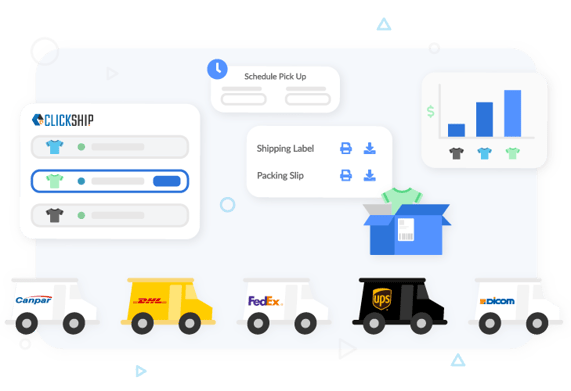Calculating shipping costs can sometimes feel like a branch of advanced quantum physics for eCommerce sellers, especially those who are just starting out.
Does it have to be that way? Absolutely not!
We are here to make sure that you understand the basics about estimating shipping rates, lowering your costs, and eventually making your business more profitable.
If you understand the variables that affect shipping rates, you can use them to make adjustments to your shipping processes and ultimately lower your shipping costs. Even if you save only a fraction more on a single shipment, those savings add up over time and you end up with more revenue generated. Doesn't that sound awesome?
So let's get down to brass tacks! First up, let's look at the factors that affect rates:
Package Dimensions & Weight
The way your packages are weighed can have a significant effect on the cost of shipping. Carriers may measure both the dead weight and dimensional weight (also known as volumetric weight), and charge the higher of the two.
What are these two kinds of weight?
Dead Weight
This is the actual weight of the shipment, without its physical size being taken into account. This is pretty simple and straightforward - the more the dead weight, the more the shipment will cost to ship.
Dimensional/Volumetric Weight
Things get a little more complicated with dimensional weight. This method of measuring weight takes into account the amount of space a package will take up in the carrier’s delivery vehicle.
It is calculated by multiplying the length, width, and height of your package, and then dividing this number by a cubic divisor, which may vary by carrier.
Using ClickShip to ship your eCommerce orders can make things easier for you! ClickShip’s Smart Packaging solution works to automatically select the optimal package for your orders. This not only increases the efficiency of your shipping process but it helps you save more on shipping!
 With ClickShip, shipping is easy, cost-effective and intuitive
With ClickShip, shipping is easy, cost-effective and intuitive
Shipping Point of Origin and Destination
The distance a shipment travels from the point of origin to the shipping destination is one of the most important factors in determining shipping costs.
As a rule, the price of shipping increases as the distance traveled becomes higher. For instance, a package traveling all the way from Canada to Bulgaria would cost much more to ship than one going from Ontario to Quebec.
Couriers such as UPS, FedEx, Canpar, Purolator and DHL base their rates on the shipping zones that you can access on their websites.
When you ship your packages with ClickShip, you’re able to get real-time rates at checkout by entering only the following information:
-
Sender address (country, postal code, city, state)
-
Receiver address (country, postal code, city, state)
-
Package dimensions and weight
Delivery Times for Shipping
Delivery time refers to how fast a shipment arrives at its destination. Faster transit times usually cost more.
Carriers typically offer a standard and express service times, depending on the country of origin and destination. The 3 primary categories offered by most big carriers are:
-
Standard delivery, which usually ranges between 2 -7 working days
-
Express deliveries, including overnight, next-day, and same-day services
-
Time-specific deliveries, which means that packages are delivered in specific slots
Tracking & Insurance
While it may be a no-brainer to include insurance and tracking to enhance customer experience, it is vital to note that these services often increase shipping costs.
| Customer experience is strategic and highly competitive, but what is it and how does shipping play a fundamental role? Download this ebook to learn all you need to delight your customers. |  |
Fortunately, with most carriers, these services are relatively inexpensive and significantly offset the risks associated with packages getting lost or damaged. For low-value packages, many carriers even offer complimentary coverage.
As the value of your packages increase, however, insurance costs rise. For your high-value packages, in fact, it is advisable to purchase additional insurance!
Delivery Surcharges
In the context of delivery, surcharges are extra costs that can accrue because of a number of reasons. While some of them can be avoided, some cannot because of the nature of the shipment, the destination or the handling required. In either case, it helps to be aware of these so you’re not surprised with the additional fees!
Some of the most common delivery surcharges include:
-
Area-related charges (for instance, for rural, or remote locations)
-
Handling fees for irregularly sized or large shipments
-
Fees for delivery to residential addresses
-
Fuel surcharges
-
Weekend delivery surcharges
Tips to Effectively Lower Your Shipping Rates
While shipping rates can lower your margins and cause you plenty of heartache, there are ways to reduce the sting of shipping costs. Here we have for you 4 ways to lower your shipping rates:
Use a third-party provider (3PL)
If most of your sales are coming from a particular region, you might want to consider using a 3PL service or fulfillment centre that is situated close to that region, instead of using your current hub.
You'll have to determine if the potential savings are worth the cost of service, but you would cut down on the average distance your orders travel and therefore effectively lower your overall costs.
Reduce dimensions by using lighter/smaller packaging
While cannot reduce the weight of your product, you can source lighter packages & packaging materials. Every bit counts, and the more weight you can drop, the more your rates will reduce.
Additionally, you could reduce dimensional weight by sourcing smaller packaging solutions to ship your goods to your customers. The reduced package size, in addition to reduced weight, will reduce your rates & lower your overall shipping costs.
Offer Free Shipping
According to a study from Deloitte, 85% of consumers prefer free shipping over fast shipping.
First, consider building shipping costs into your product pricing strategy.
Second, consider providing free shipping with a minimum purchase at a cost-effective transit time, as well as providing a real-time or flat rate expedited shipping option for customers that want their goods ASAP
Get access to discounted shipping rates
Working with a responsive shipping partner who can offer you industry-leading shipping rates is certainly something you should look into if you want to lower costs.
Freightcom is just the partner you need! We offer a host of features and deeply discounted rates from top-tier carriers.
Reach out to us to learn more!
Opting for Freightcom also gives you access to our eCommerce shipping solution ClickShip, which allows you to automate your shipping process and gives you access to some of the lowest shipping rates.

.png?width=250&height=58&name=MicrosoftTeams-image%20(28).png)